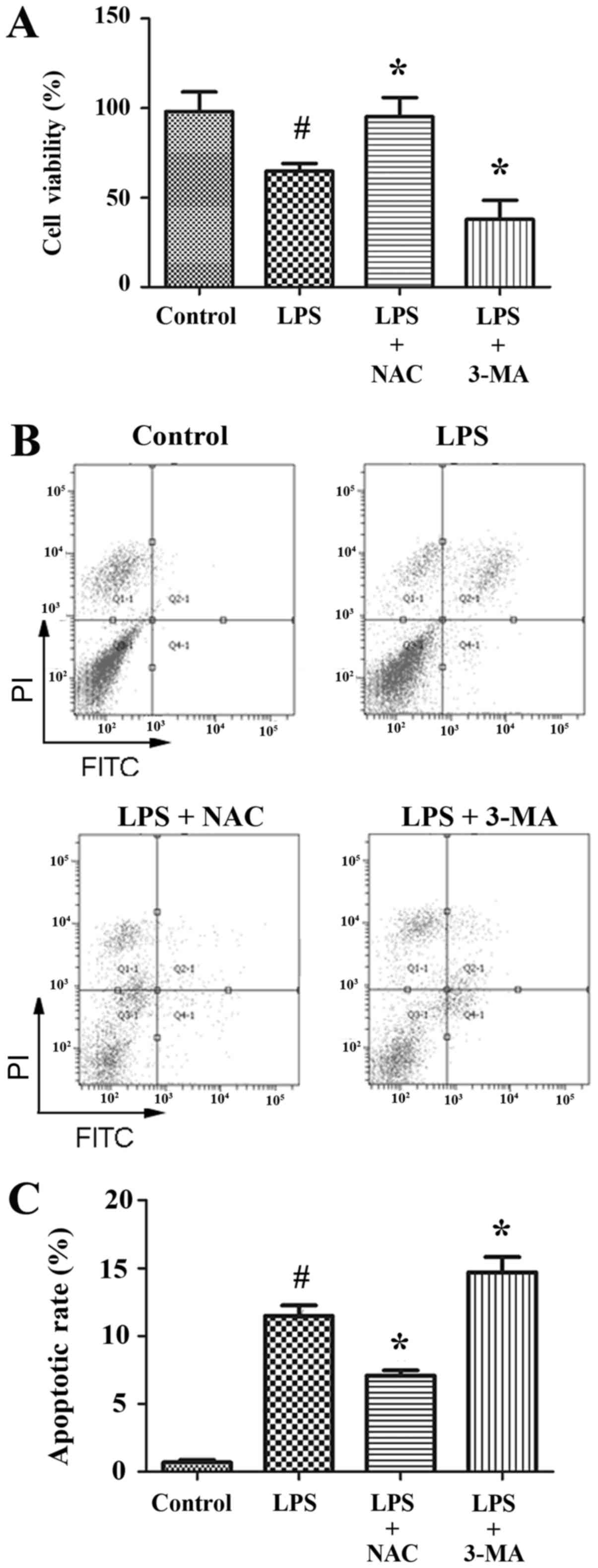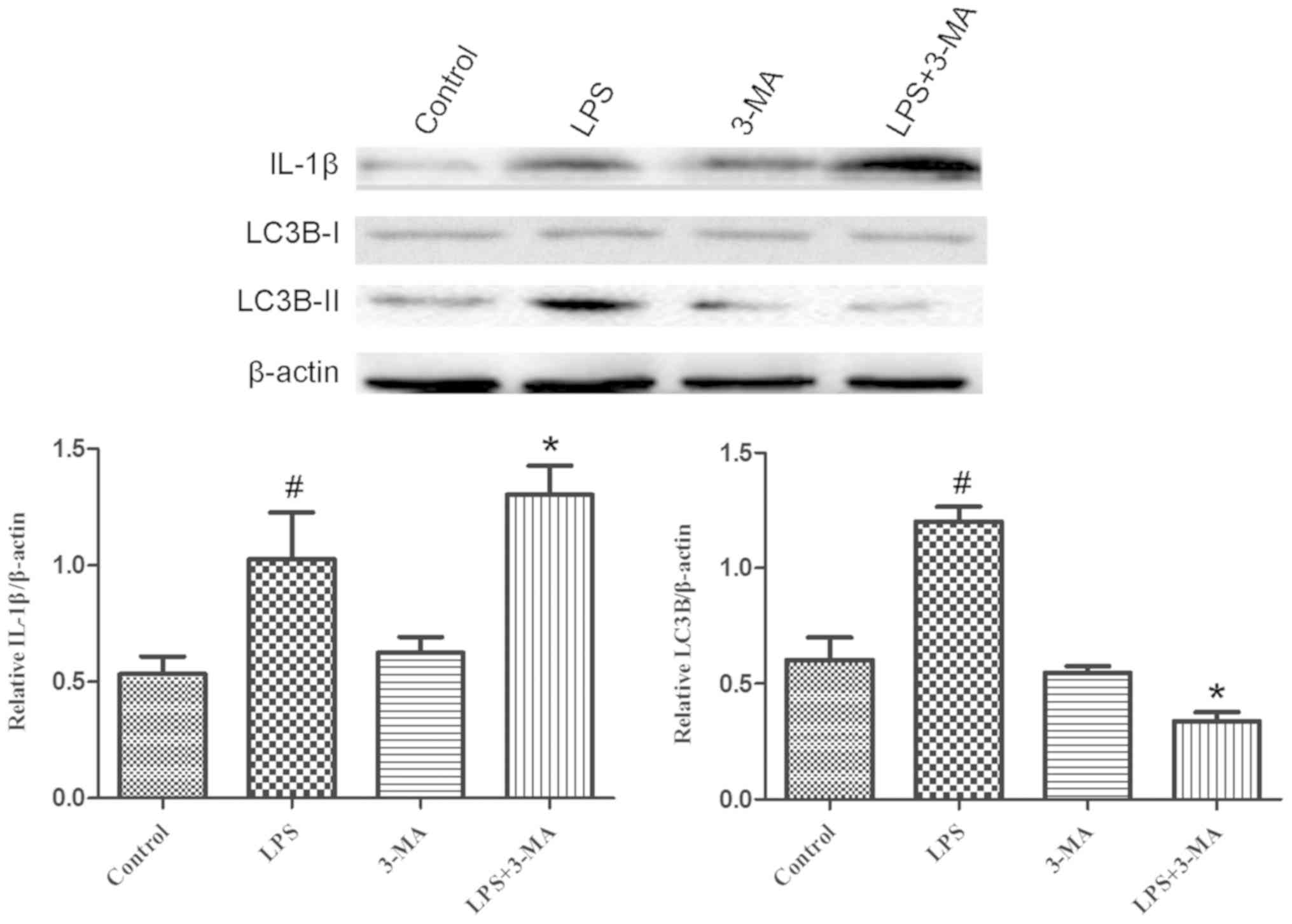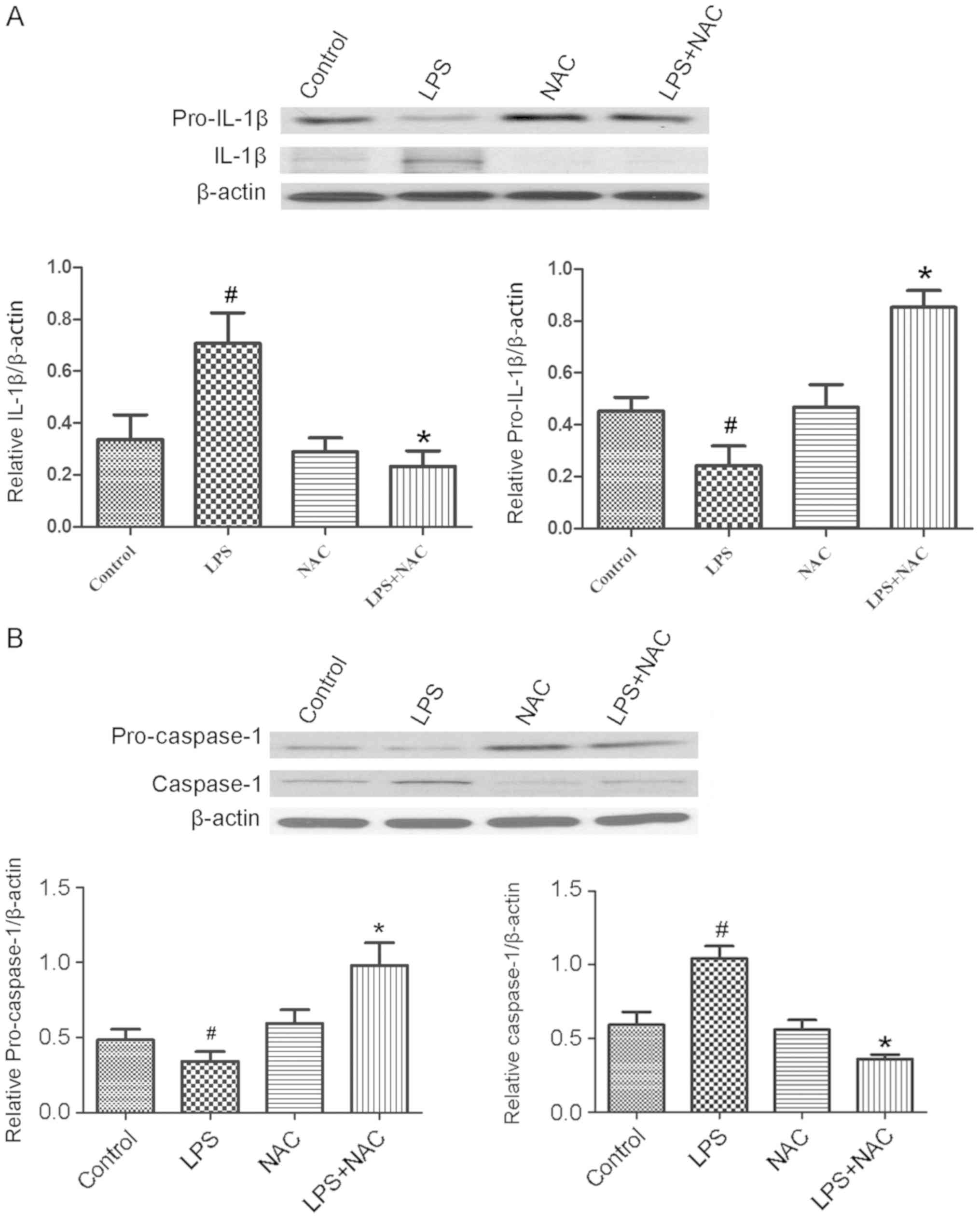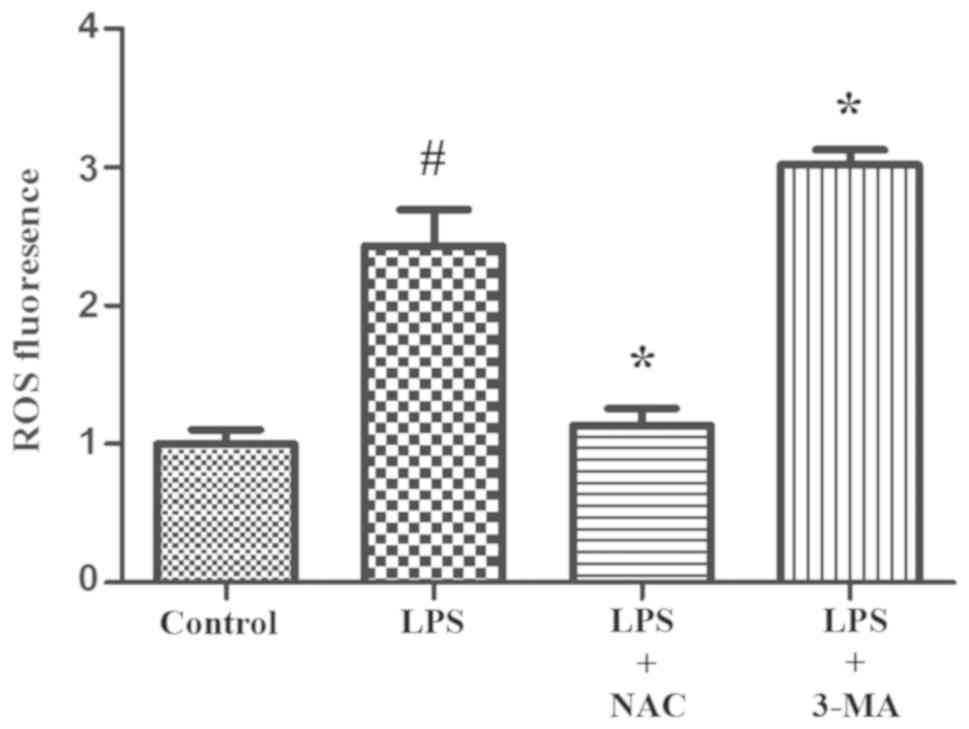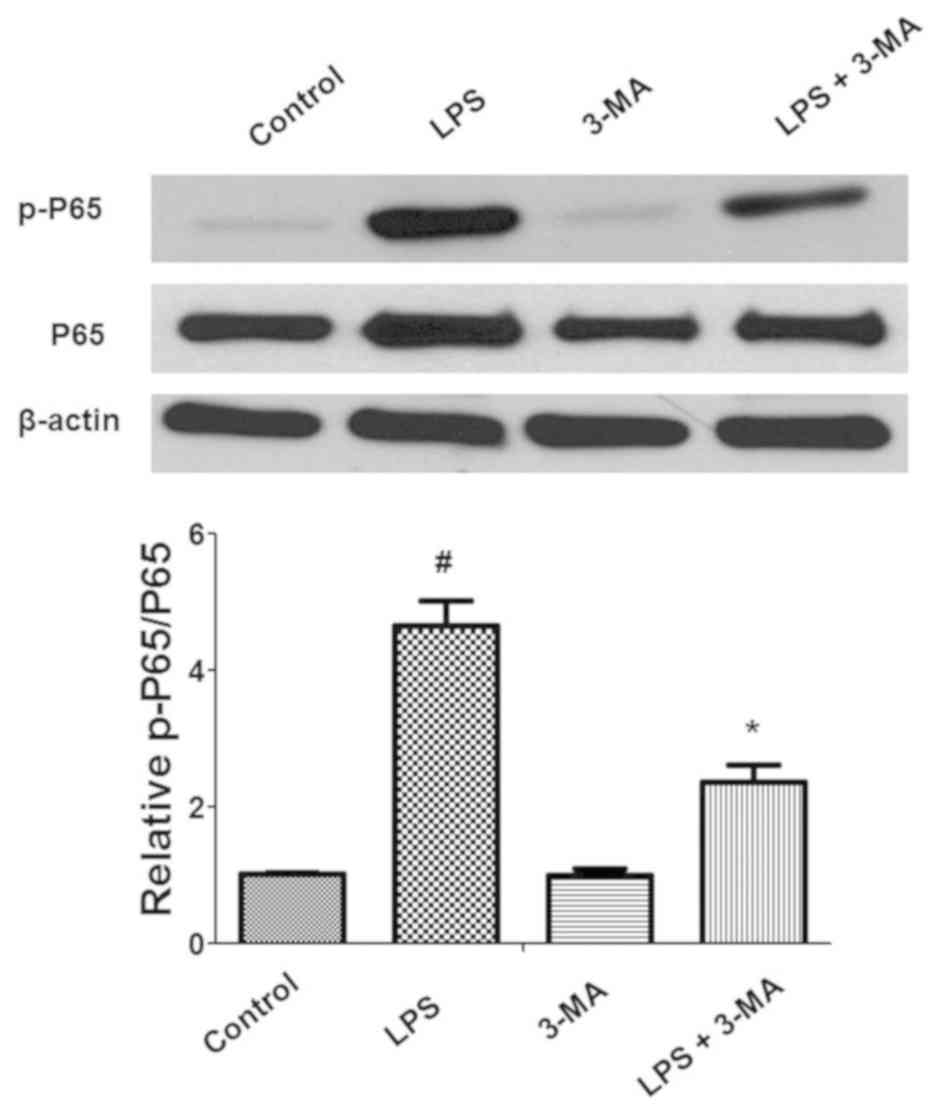Role of autophagy in LPS‑induced inflammation in INS‑1 cells
- Authors:
- Published online on: April 19, 2019 https://doi.org/10.3892/mmr.2019.10172
- Pages: 5211-5218
Abstract
Introduction
The incidence rate of type 2 diabetes (T2D) is rising sharply around the world. T2D is classified as a metabolic disorder, but increasing evidence has indicated that it is also strongly associated with inflammation mediated by the innate immune system (1,2). Unlike type 1 diabetes (T1D), the inflammatory response in the islets of patients with T2D is ‘low grade’. It was demonstrated that elevated circulating levels of interleukin (IL)-1β, IL-6, MCP1 and C-reactive protein are predictive of T2D; these inflammatory cytokines are known to induce insulin resistance and impair insulin secretion (1). In particular, IL-1β was found to regulate pancreatic β-cell death and dysfunction (2). Several studies have described the involvement of IL-1β in T1D; IL-1β is also an important inflammatory mediator in T2D (1,2). Currently, clinical trials using IL-1β-blocking antibodies to treat patients with T2D have been very encouraging, clearly indicating that IL-1β plays vital roles in the onset of T2D.
Recently, a large number of studies have clarified the mechanisms by which biologically active IL-1β is produced. The secretion of bioactive IL-1β is primarily controlled by the activation of caspase-1 through the assembly of inflammasomes formed by NOD-like receptor family pyrin domain-containing protein 3 (NLRP3), the adaptor protein ASC and procaspase-1. The best-characterized inflammasome protein to date is NLRP3, which is also recognized as a sensor of metabolic dysregulation, such as the pathogenic status of T2D (3). In pancreatic β-cells and macrophages, increased reactive oxygen species (ROS) triggers the activation of the NLRP3 inflammasome through a thioredoxin interacting protein (TXNIP)- or islet amyloid polypeptide-dependent pathway, respectively. In addition, TXNIP−/− or NLRP3−/− mice showed improved glucose tolerance and insulin sensitivity (2). These studies encouraged the hypothesis that the NLRP3 inflammasome mediates IL-1β secretion, and IL-1β mechanistically regulates the pathogenesis of T2D.
Autophagy has been demonstrated to be necessary to maintain the structure, mass and function of pancreatic β-cells (4). In T1D and T2D, chronic elevation of blood glucose concentration causes an imbalance of antioxidant activity in cells, leading to oxidative/nitrosative-mediated stress and injury. Furthermore, a study has indicated that autophagy serves as a defense mechanism to clear proteins and organelles damaged by oxidative stress (5). Autophagy is also implicated in the maintenance of mitochondrial function by facilitating mitochondrial turnover (6). Mitochondria are the primary site of ROS generation, and accumulated ROS induce mitochondria damage and dysfunction. Thus, autophagy has a vital role in the maintenance of the structural and functional integrity of mitochondria (7), and impaired autophagy may result in the accumulation of ROS (8–10). Therefore, impaired autophagy associated with ROS accumulation may contribute to insulin resistance and pancreatic β-cell dysfunction. Autophagy, as a dynamic lysosomal degradation of damaged organelles and proteins, may be associated with the dysfunction and death of pancreatic β-cells, which contributes to the onset of T2D. Although IL-1β is an important inflammatory mediator of T2D (11), the process leading to the increased expression and secretion of IL-1β in T2D remains unclear. The current results indicated that enhanced autophagy may induce mitochondrial damage, inhibit the accumulation of ROS and subsequently suppress IL-1β production. Therefore, the role of autophagy was investigated in diabetes-induced hyperlipemic INS-1 cells with lipopolysaccharide (LPS)-induced inflammasome activation and IL-1β production. The aim of this research was to investigate the association between the autophagy and inflammation in INS-1 cells, which hoped to provide novel ideas for T2D treatment.
Materials and methods
Cell culture
INS-1 cells were acquired from the Department of Endocrinology, The Second Affiliated Hospital of Harbin Medical University (Harbin, China). INS-1 cells were passaged in RPMI-1640 medium (Thermo Fisher Scientific, Inc., Waltham, MA, USA) supplemented with 10% (v/v) fetal bovine serum (FBS; Hangzhou Sijiqing Biological Engineering Materials Co., Ltd., Hangzhou, China) in a humidified atmosphere containing 95% air and 5% CO2 (12). The cells were treated with LPS (100 ng/ml; Sigma-Aldrich; Merck KGaA, Darmstadt, Germany) for 24 h. N-acetyl-L-cysteine (NAC; 5 µM; Sigma-Aldrich; Merck KGaA) was used to inhibit ROS (13) and 3-methyladenine (3-MA; 5 mM; Sigma-Aldrich; Merck KGaA) was used to inhibit autophagy (4).
Cell viability assay
Cell viability was assessed using Cell Counting Kit 8 (CCK8) (Dojindo Molecular Technologies, Inc., Kumamoto, Japan) according to the manufacturer's protocol (12). Briefly, the cells were treated with LPS (100 ng/ml), NAC (5 µM) and 3-MA (5 mM) for 24 h, and the detail treatments for each experiment were displayed in the figure legends. The INS-1 cells were plated in 96-well plates at a density of 5×103 per well and treated with CCK8 solution at 37°C for 1 h. Absorbance was detected using a microplate reader at a wavelength of 450 nm (12).
Apoptosis assay
Cell apoptosis was detected using flow cytometry. INS-1 cells were stained with Annexin V and propidium iodide (PI) using the Annexin-V-FLUOS staining kit (Roche Diagnostics, Basel, Switzerland) in accordance with the manufacturer's protocol. Briefly, the INS-1 cells were plated in 24-well plates (1.2×105 cells/cm2), treated with lysosomal proteases, and stained with Annexin V (1 µM) and PI (0.1 µM) for 10 min at 25°C in the dark. Images of the apoptotic cells were analyzed using a fluorescence microscope (Nikon Eclipse TE2000-U; Nikon Corporation, Tokyo, Japan) with an excitation wavelength in the range of 450–500 nm and a detection wavelength in the range of 515–565 nm (14).
Intracellular ROS measurement
2′,7′-Dichlorofluorescin diacetate (DCFH-DA) was used to analyze intracellular ROS by flow cytometry. INS-1 cells were divided into four groups (control, LPS, LPS + NAC or LPS + 3-MA), seeded in 6-well plates (1×106 cells/ml) and incubated for 24 h. Then, DCFH-DA (10 µM) was incubated with the cells for 20 min at 37°C. The medium including DCFH-DA was aspirated to remove the extracellular dye, washed with serum-free medium three times and then ice-cold serum-free medium was added to the cells. The cells were placed on ice in the dark. The fluorescence was measured using a flow cytometer (BD FACSCalibur; BD Biosciences, Franklin Lakes, NJ, USA) at an excitation wavelength of 488 nm and an emission wavelength of 530 nm, and the data was analyzed by using FACSDiva version 6.1.2 (BD Biosciences).
Western blotting
Cells were washed with PBS and lysed in lysis buffer [62.5 mM Tris-HCl (pH 6.8), 2% SDS, 5% 2-Mercaptoethanol (BME), 1% TritonX-100, 1 mM EDTA, 1 mM EGTA, 10 mM dithiothreitol and 1 mm Na3VO4]. The lysates were then incubated on ice for 30 min, followed by centrifugation at 8,000 × g for 5 min at 4°C. The protein concentrations were determined using a bicinchoninic acid assay. Equal quantities of protein (50 µg) were separated by SDS-PAGE on 10–15% gels. Following the transfer of the proteins to polyvinylidine difluoride membranes, the blots were blocked with 5% non-fat dry milk at room temperature for 1 h. The membranes were exposed to specific primary antibodies at 4°C overnight. The following antibodies were used at a 1:1,000 dilution: Light chain 3 (LC3; Cell Signaling Technology, Inc., Danvers, MA, USA; cat. no. 2775), IL-1β (Cell Signaling Technology, Inc.; cat. no. 2002), caspase-1 (Abcam, Cambridge, UK; cat. no. 2225), NF-kB p65 (Abcam, Cambridge, UK; cat. no. ab16502)and β-actin (Cell Signaling Technology, Inc.; cat. no. 8475). The membranes were washed with PBS containing 0.1% of Tween-20 three times, then incubated with horseradish peroxidase-conjugated secondary antibodies (AP178P; cat. no. AC111P; 1:5,000; Sigma-Aldrich; Merck KGaA) at room temperature for 1 h (12). Protein bands were detected using enhanced chemiluminescence (Beyotime Institute of Biochemistry, Haimen, China). Immunoblots were quantified by densitometric analysis using Image Lab software v2.0.1 (Bio-Rad Laboratories, Inc., Hercules, CA, USA). The relative expression level of a certain protein was normalized to β-actin and experiments were repeated in triplicate.
Transmission electron microscopy (TEM)
The INS-1 cells were fixed in 2% paraformaldehyde and 2.5% glutaraldehyde in phosphate buffer (pH 7.4) at room temperature for 1 h, followed by 1% OsO4 at room temperature for 1 h. The cells were dehydrated through a graded ethanol series (70, 80, 95 and 100%, 5 min each) and then embedded using the Quetol 651 Embedding Kit (Polysciences, Inc., Warrington, PA, USA). The embedded cells were sliced into 70 nm sections. Then the sections were exposed to uranyl acetate (1%) and lead citrate (1%) at room temperature for 30 min, then wash with ddH2O three times and examined by TEM (magnification, ×40,000; H-7100; Hitachi, Ltd., Tokyo, Japan) as marked in the figure legends.
Statistical analysis
All values are reported as the mean ± standard deviation. Comparisons of a single variable in more than two groups were evaluated using one-way analysis of variance followed by Tukey's multiple comparison tests using GraphPad Prism Version 5 (GraphPad Software, Inc., La Jolla, CA, USA). Data were analyzed using the paired and unpaired t-test between two groups using SPSS 12.0 software (SPSS, Inc., Chicago, IL, USA). P<0.05 was considered to indicate a statistically significant difference.
Results
LPS induces INS-1 cell apoptosis and autophagy
LPS, an outer membrane component of Gram negative bacteria, has been linked to obesity and insulin resistance (15). It has been reported that high fat-containing diets elevate enterobacterial production and the translocation of LPS to cells, while LPS administration to healthy subjects rapidly induced insulin resistance (16). Thus, the effect of LPS (100 ng/ml, 24 h) on INS-1 cells viability was investigated in the current study. LPS treatment significantly decreased the viability of INS-1 cells (67%) compared with non-treated cells (Fig. 1A). Using an Annexin V-FITC/PI quantification assay apoptosis was detected in LPS-treated INS-1 cells. LPS dramatically increased the number of apoptotic cells (11.5%) compared with the control group (0.7%; Fig. 1B and C). The activation of autophagy in INS-1 cells by LPS (100 ng/ml) was detected by electron microscopy. In INS-1 cells, double-membrane autophagic vesicles containing cell organelles in the cytoplasm of INS-1 cells formed an integrated autophagosome (Fig. 2). LPS treatment increased the formation of autophagic vesicles, and 3-MA treatment ameliorated the LPS-induced increase of autophagic vesicles formation (Fig. 2). LC3B protein expression was detected by western blotting, which further corroborated that LPS activated autophagy in INS-1 cells. LC3B is a soluble protein distributed ubiquitously in mammalian cells. Upon the induction of autophagy, LC3B is cleaved by Atg4B to generate LC3B-II. Therefore LC3B is considered a specific autophagy marker (17). As expected, the expression of LC3B-II was remarkably increased in INS-1 cells following LPS treatment (Fig. 3).
Role of autophagy in the LPS-induced Caspase 1 cleavage and IL-1β maturation
Previous studies have indicated that autophagy protects INS-1 cell viability under various challenges, including palmitate and ROS-induced damage (18,19). However, the role of autophagy in the inflammation of pancreatic β-cells (INS-1) has not been well established. To investigate the role of autophagy in LPS-induced INS-1 cell death, 3-MA, a specific autophagy inhibitor, was used. Treatment with 3-MA only did not exhibit a significant effect on cell proliferation and viability in INS-1 cells (data not shown). Following pre-treatment with 3-MA (5 mM, 24 h), the viability of LPS-treated INS-1 cells was decreased to 40% (Fig. 1A), which was significantly lower than that of INS-1 cells only treated with LPS only (67%). Similarly, apoptosis was also increased to 14.7% in LPS-treated INS-1 cells pretreated with 3-MA (Fig. 1B and C), which was significantly higher than that of LPS-treated INS-1 cells. Subsequently, the expression of IL-1β and LC3B was determined using western blotting. The expression of LC3B-II was markedly decreased in LPS-treated INS-1 cells pretreated with 3-MA compared with that of INS-1 cells treated with LPS only (Fig. 3). Notably, the expression of IL-1β was significantly enhanced in LPS-treated INS-1 cells pretreated with 3-MA, which was higher than that of INS-1 cells treated with LPS only (Fig. 3). These results demonstrated that autophagy may have protective effects on the LPS-induced inflammation of INS-1 cells; autophagy may also be necessary for the maintenance of the normal architecture and function of INS-1 cells.
Inhibition of autophagy augments inflammation via ROS-mediated Caspase 1 cleavage and IL-1β maturation
It was also investigated how autophagy regulates LPS-induced NLRP3 inflammasome activation in INS-1 cells. ROS activate the NLRP3 inflammasome, amplify the inflammatory response and promote pro-inflammatory cytokine secretion. Therefore, it was hypothesized that ROS have an important role in LPS-induced NLRP3 inflammasome activation. Thus, NAC (an ROS inhibitor) was used to abolish ROS in INS-1 cells (13). The expression levels of cleaved caspase-1 and secreted IL-1β were markedly increased in INS-1 cells following LPS treatment (100 ng/ml for 24 h), which may indicate the activation of inflammasomes, especially for NLRP3 inflammasome (Fig. 4). Additionally, a significant increase in ROS production was observed in the LPS treated INS-1 cells compared with the control cells (Fig. 5). On the other hand, when ROS levels were inhibited by NAC (5 µM), the expression of IL-1β was decreased, which was accompanied by the significantly enhanced expression of pro-IL-1β (Fig. 4A). Similarly, the expression of caspase-1 was significantly decreased by NAC following LPS stimulation, which was accompanied by the significantly enhanced expression of pro-caspase-1 (Fig. 4B). These results suggested that the inhibition of ROS suppressed NLRP3 inflammasome activation and reduced the maturation of IL-1β.
Whether autophagy protects against NLRP3 inflammasome activation through the inhibition of ROS accumulation was also investigated. LPS treatment (100 ng/ml, 24 h) elevated ROS generation in INS-1 cells (Fig. 5). Pretreatment with 3-MA (5 mM, 24 h), an autophagy inhibitor, significantly increased the ROS level in LPS-treated INS-1 cells (Fig. 5) and decreased the expression of LC3B-II (Fig. 3).
Additionally, the effect of autophagy on nuclear factor-κB (NF-κB) activation during inflammation was also determined. LPS significantly induced the phosphorylation of P65, which promotes the translocation of P65 to the cell nucleus and activation of the NF-κB pathway (Fig. 6). Pretreatment with 3-MA significantly attenuated LPS-induced phosphorylation of P65 in INS-1 cells. Collectively, these data indicated that ROS and NF-κB signaling were associated with inflammation and autophagy in INS-1 cells.
Discussion
Type 2 diabetes (T2D) is clearly associated with chronic low-grade inflammation, lipotoxicity and glucotoxicity (1,20). Autophagy also has a role in T2D progression by impairing pancreatic β-cell function and promoting insulin resistance. However, the complete role of autophagy in T2D remains unclear. To investigate the association between inflammation and T2D, whether LPS contributed to IL-1β generation in INS-1 cells was investigated. In the current study, the data indicated that LPS induced IL-1β production, and that the inhibition of autophagy by 3-MA reduced cell viability and increased apoptosis in INS-1 cells. This indicated that autophagy is required for INS-1 cell survival. Furthermore, it was demonstrated that autophagy protects against LPS-induced INS-1 cell death by blocking the ROS-dependent activation of the NLRP3 inflammasome and IL-1β production in INS-1 cells.
Previous studies demonstrated that IL-1β expression is elevated in human β-cells in response to high concentrations of glucose (21,22). In β-cells from humans and rats, IL-1β expression is strongly enhanced by autostimulatory processes (21,23). Previous investigations using an immunoaffinity column containing anti-human IL-1β polyclonal antibodies indicated that IL-1β is toxic to insulin-producing β-cells (24). Regardless of the mechanism of action, clinical proof of the importance of IL-1β in β-cell failure has been obtained in patients with T2D (25,26). In the present study, LPS induced IL-1β production in INS-1 cells. The concentration of IL-1β was relatively low because β-cells were used, rather than macrophages or other inflammatory cells (27). Indeed, even at low concentrations, IL-1β has been reported to negatively influence β-cell function and turnover (28).
Autophagy is necessary to maintain the structure, mass and function of pancreatic β-cells (4). The findings of the current study indicated that autophagy may be an important factor in the development of T2D. When autophagy was inhibited with 3-MA, ROS generation was significantly increased, which was accompanied by enhanced expression of IL-1β in INS-1 cells. Additionally, the inhibition of ROS generation by NAC dramatically decreased the expression of IL-1β in INS-1 cells. The results demonstrated that the stimulation of autophagic activity may confer beneficial anti-inflammatory effects through the removal of ROS. Similar results were observed in aging cells with activated inflammasomes; these investigations indicated that autophagy is an important regulator of innate immune responses in the host defense (29). Furthermore, recent studies have demonstrated that the inhibition of mitophagy may lead to the accumulation of damaged mitochondria that produce ROS and consequently activate the inflammasome (30). By contrast, there is now convincing experimental data to demonstrate that efficient autophagy can prevent inflammasome activation and inflammatory responses (31).
The current study further investigated how autophagy regulates the process of IL-1β secretion in LPS-challenged INS-1 cells. IL-1β is produced as an inactive cytoplasmic precursor, pro-IL-1β, and requires proteolytic cleavage to become bioactive. Caspase-1 was initially identified as the main IL-1β-converting enzyme. It is synthesized as a zymogen, pro-caspase-1, that is subsequently converted to active caspase-1 through cleavage, and binds to NLRP3 to form the inflammasome. The findings of the current study demonstrated that the expression of IL-1β was significantly enhanced and pro-IL-1β expression was decreased by treatment with LPS. Additionally, the expression of caspase-1 was enhanced and the expression of pro-caspase-1 was decreased. Similarly, a recent study demonstrated that LPS treatment triggered IL-1β secretion via the NLRP3 inflammasome. It was also demonstrated that caspase-1 clustering induces the activation of, and the caspase-1-dependent maturation and secretion of IL-1β (32). The results suggested that the inhibition of autophagy may promote ROS generation, NLRP3 inflammasome complex formation and the activation of caspase-1, which results in the cleavage of pro-IL-1β to form mature IL-1β.
There are many shortcomings to this study, for example more experiments are needed to investigate the interrelationship between autophagy and inflammation, and the effect of them on the T2D progression and potential molecular mechanism. A previous study demonstrated the inhibition of autophagy may lead to the accumulation of damaged mitochondria that produce ROS and consequently activate inflammation, which induces pancreatic β-cell death and dysfunction (33). However, the molecular mechanism of β-cell death in this context is not well understood and, therefore, requires further research.
In conclusion, the findings of the current study demonstrated that autophagy has a protective role in the LPS-induced inflammatory response and cell death. Whether LPS-induced NLRP3/caspase-1 activation triggered IL-1β generation through the promotion of ROS accumulation was also investigated. Furthermore, ROS generation suppressed by autophagy may be a key mechanism for the inhibition of IL-1β expression in INS-1 cells. These results suggest that autophagy may be a potential therapeutic target to delay the inflammatory response in T2D.
Acknowledgements
Not applicable.
Funding
The present work was supported by two grants from the National Natural Science Foundation of China (grant nos. 81370929 and 81770820), a grant from the Novo Nordisk China Diabetes Young Scientific Talent Research Funding-2016 and a clinical medicine grant from the Chinese Medical Association (grant no. 13040670452).
Availability of data and materials
All data generated or analyzed during the present study are included in this published article.
Authors' contributions
LZ and MC performed the cell experiments. JW and YS performed intracellular ROS measurements and western blot analysis, WJ and GL performed transmission electron microscopy. YL contributed to the study design and to the writing of the manuscript.
Ethics approval and consent to participate
The present study was approved by Ethic Committee of First Affiliated Hospital of Harbin Medical University
Patient consent for publication
Not applicable.
Competing interests
The authors declare that they have no conflict of interest
Glossary
Abbreviations
Abbreviations:
|
LPS |
lipopolysaccharide |
|
NAC |
N-acetyl-L-cysteine |
|
IL-1β |
interleukin-1β |
|
DCFH-DA |
2′,7′-dichlorofluorescein diacetate |
|
LC3 |
light chain 3 |
|
NLRP3 |
NOD-like receptor family pyrin domain-containing protein 3 |
|
T2D |
type 2 diabetes |
|
CCK8 |
Cell Counting Kit-8 |
|
3-MA |
3-methyladenine |
|
T1D |
type 1 diabetes |
|
ROS |
reactive oxygen species |
|
TEM |
transmission electron microscopy |
|
SD |
standard deviation |
References
|
Donath MY and Shoelson SE: Type 2 diabetes as an inflammatory disease. Nat Rev Immunol. 11:98–107. 2011. View Article : Google Scholar : PubMed/NCBI | |
|
Eguchi K and Manabe I: Macrophages and islet inflammation in type 2 diabetes. Diabetes Obes Metab. 3 (Suppl 15):S152–S158. 2013. View Article : Google Scholar | |
|
Yang CM, Shin DM and Jo EK: The role of NLR-related protein3 inflammasome in host defense and inflammatory diseases. Int Neurourol J. 16:2–12. 2012. View Article : Google Scholar : PubMed/NCBI | |
|
Masini M, Bugliani M, Lupi R, del Guerra S, Boggi U, Filipponi F, Marselli L, Masiello P and Marchetti P: Autophagy in human type 2 diabetes pancreatic beta cells. Diabetologia. 52:1083–1086. 2009. View Article : Google Scholar : PubMed/NCBI | |
|
Gomes LC, Di Benedetto G and Scorrano L: During autophagy mitochondria elongate, are spared from degradation and sustain cell viability. Nat Cell Biol. 13:589–598. 2011. View Article : Google Scholar : PubMed/NCBI | |
|
Goldman SJ, Taylor R, Zhang Y and Jin S: Autophagy and the degradation of mitochondria. Mitochondrion. 10:309–315. 2010. View Article : Google Scholar : PubMed/NCBI | |
|
Lee J, Giordano S and Zhang J: Autophagy, mitochondria and oxidative stress: Cross-talk and redox signalling. Biochem J. 441:523–540. 2012. View Article : Google Scholar : PubMed/NCBI | |
|
Twig G, Elorza A, Molina AJ, Mohamed H, Wikstrom JD, Walzer G, Stiles L, Haigh SE, Katz S, Las G, et al: Fission and selective fusion govern mitochondrial segregation and elimination by autophagy. EMBO J. 27:433–446. 2008. View Article : Google Scholar : PubMed/NCBI | |
|
Tal MC, Sasai M, Lee HK, Yordy B, Shadel GS and Lwasaki A: Absence of autophagy results in reactive oxygen species-dependent amplification of RLR signaling. Proc Natl Acad Sci USA. 106:2770–2775. 2009. View Article : Google Scholar : PubMed/NCBI | |
|
Petersen KF, Dufour S, Befroy D, Garcia R and Shulman GI: Impaired mitochondrial activity in the insulin-resistant offspring of patients with type 2 diabetes. N Eng J Med. 350:664–671. 2004. View Article : Google Scholar | |
|
Masters SL, Dunne A, Subramanian SL, Hull RL, Tannahill GM, Sharp FA, Becker C, Franchi L, Yoshihara E, Chen Z, et al: Activation of the Nlrp3 inflammasome by islet amyloid polypeptide provides a mechanism for enhanced IL-1β in type 2 diabetes. Nat Immunol. 11:897–904. 2010. View Article : Google Scholar : PubMed/NCBI | |
|
Jing Yin J, Bo Li Y, Ming Cao M and Wang Y: Liraglutide improves the survival of INS-1 cells by promoting macroau-tophagy. Int J Endocrinol Metab. 11:184–190. 2013. View Article : Google Scholar : PubMed/NCBI | |
|
Wen H, Gris D, Lei Y, Jha S, Zhang L, Huang MT, Brickey WJ and Ting JP: Fatty acid-induced NLRP3ASC inflammasome activation interferes with insulin signaling. Nat Immunol. 12:408–415. 2011. View Article : Google Scholar : PubMed/NCBI | |
|
Chan JY, Cooney GJ, Biden TJ and Laybutt DR: Differential regulation of adaptive and apoptotic unfolded protein response signalling by cytokine-induced nitric oxide production in mouse pancreatic beta cells. Diabetologia. 54:1766–1776. 2011. View Article : Google Scholar : PubMed/NCBI | |
|
Cani PD, Amar J, Iglesias MA, Poggi M, Knauf C, Bastelica D, Neyrinck AM, Fava F, Tuohy KM, Chabo C, et al: Metabolic endotoxemia initiates obesity and insulin resistance. Diabetes. 56:1761–1772. 2007. View Article : Google Scholar : PubMed/NCBI | |
|
Van der Crabben SN, Blümer RM, Stegenga ME, Ackermans MT, Endert E, Tanck MW, Serlie MJ, van der Poll T and Sauerwein HP: Early endotoxemia increases peripheral and hepatic insulin sensitivity in healthy humans. J Clin Endocrinol Metab. 94:463–468. 2009. View Article : Google Scholar : PubMed/NCBI | |
|
Kabeya Y, Mizushima N, Ueno T, Yamamoto A, Kirisako T, Noda T, Kominami E, Ohsumi Y and Yoshimori T: LC3, a mammalian homologue of yeast Apg8p, is localized in autophagosome membranes after processing. EMBO J. 19:5720–5728. 2000. View Article : Google Scholar : PubMed/NCBI | |
|
Choi SE, Lee SM, Lee YJ, Li LJ, Lee SJ, Lee JH, Kim Y, Jun HS, Lee KW and Kang Y: Protective role of autophagy in palmitate-induced INS-1 beta-cell death. Endocrinology. 150:126–134. 2009. View Article : Google Scholar : PubMed/NCBI | |
|
Xia G, Zhu T, Li X, Jin Y, Zhou J and Xiao J: ROS-mediated autophagy through the AMPK signaling pathway protects INS-1 cells from human islet amyloid polypeptide-induced cytotoxicity. Mol Med Rep. 18:2744–2752. 2018.PubMed/NCBI | |
|
Ashcroft FM, Rohm M, Clark A and Brereton MF: Is type 2 diabetes a glycogen storage disease of pancreatic β Cells? Cell Metab. 26:17–23. 2017. View Article : Google Scholar : PubMed/NCBI | |
|
Böni-Schnetzler M, Thorne J, Parnaud G, Marselli L, Ehses JA, Kerr-Conte J, Pattou F, Halban PA, Weir GC and Donath MY: Increased interleukin (IL)-1β messenger ribonucleic acid expression in beta-cells of individuals with type 2 diabetes and regulation of IL-1beta in human islets by glucose and autostimulation. J Clin Endocrinol Metab. 93:4065–4074. 2008. View Article : Google Scholar : PubMed/NCBI | |
|
Maedler K, Sergeev P, Ris F, Oberholzer J, Joller-Jemelka HI, Spinas GA, Kaiser N, Halban PA and Donath MY: Glucose-induced beta-cell production of interleukin-1beta contributes to glucotoxicity in human pancreatic islets. J Clin Invest. 110:851–860. 2002. View Article : Google Scholar : PubMed/NCBI | |
|
Ribaux P, Ehses JA, Lin-Marq N, Carrozzino F, Böni-Schnetzler M, Hammar E, Irminger JC, Donath MY and Halban PA: Induction of CXCL1 by extracellular matrix and autocrine enhancement by interleukin-1 in rat pancreatic beta-cells. Endocrinology. 148:5582–5590. 2007. View Article : Google Scholar : PubMed/NCBI | |
|
Mandrup-Poulsen T, Bendtzen K, Nerup J, Dinarello CA, Svenson M and Nielsen JH: Affinity-purified human interleukin I is cytotoxic to isolated islets of langerhans. Diabetologia. 29:63–67. 1986. View Article : Google Scholar : PubMed/NCBI | |
|
Donath MY, Schumann DM, Faulenbach M, Ellingsgaard H, Perren A and Ehses JA: Islet inflammation in Type 2 diabetes: from metabolic stress to therapy. Diabetes Care. 2 (Suppl 31):S161–S164. 2008. View Article : Google Scholar | |
|
Schroder K and Tschopp J: The inflammasomes. Cell. 140:821–832. 2010. View Article : Google Scholar : PubMed/NCBI | |
|
Zhao G, Dharmadhikari G, Maedler K and Meyer-Hermann M: Possible role of interleukin-1β in type 2 diabetes onset and implications for anti-inflammatory therapy strategies. PLoS Comput Biol. 10:e10037982014. View Article : Google Scholar : PubMed/NCBI | |
|
Maedler K, Schumann DM, Sauter N, Ellingsgaard H, Bosco D, Baertschiger R, Iwakura Y, Oberholzer J, Wollheim CB, Gauthier BR and Donath MY: Low concentration of interleukin-1beta induces FLICE-inhibitory protein-mediated β-cell proliferation in human pancreatic islets. Diabetes. 55:2713–2722. 2006. View Article : Google Scholar : PubMed/NCBI | |
|
Green DR, Galluzzi L and Kroemer G: Mitochondria and the autophagy-inflammation-cell death axis in organismal aging. Science. 333:1109–1112. 2011. View Article : Google Scholar : PubMed/NCBI | |
|
Singh R and Cuervo AM: Autophagy in the cellular energetic balance. Cell Metab. 13:495–504. 2011. View Article : Google Scholar : PubMed/NCBI | |
|
Kroemer G and Levine B: Autophagic cell death: The story of a misnomer. Nat Rev Mol Cell Biol. 9:1004–1010. 2008. View Article : Google Scholar : PubMed/NCBI | |
|
Zhou R, Tardivel A, Thorens B, Choi I and Tschopp J: Thioredoxin-in-teracting protein links oxidative stress to inflammasome activation. Nat Immunol. 11:136–140. 2010. View Article : Google Scholar : PubMed/NCBI | |
|
Lohitesh K, Saini H, Srivastava A, Mukherjee S, Roy A and Chowdhury R: Autophagy inhibition potentiates SAHA-mediated apoptosis in glioblastoma cells by accumulation of damaged mitochondria. Oncol Rep. 39:2787–2796. 2018.PubMed/NCBI |



